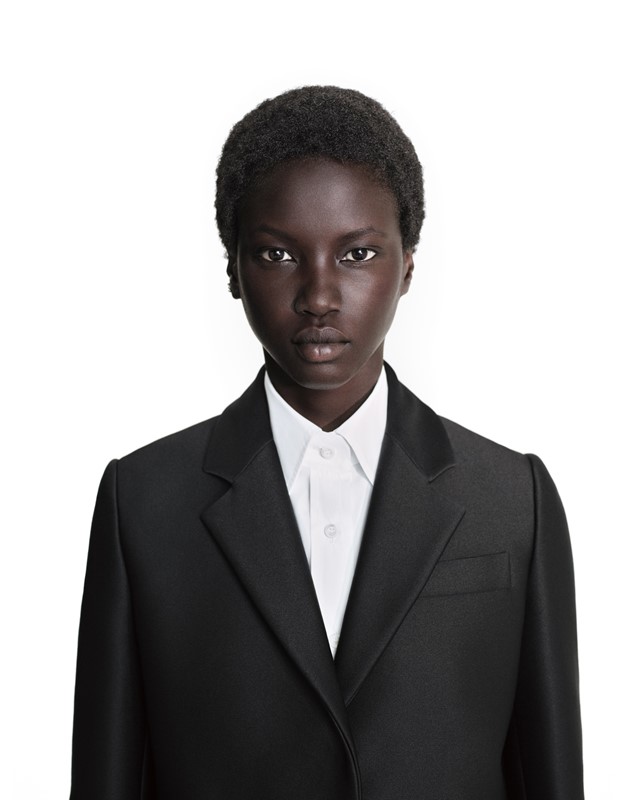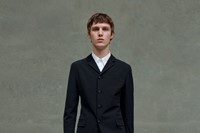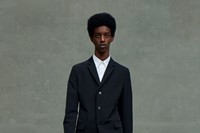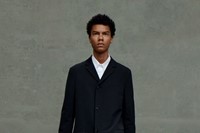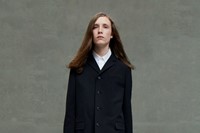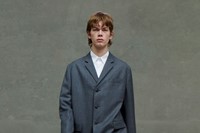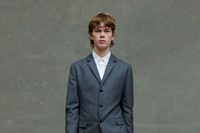Presented via a collaborative film, Miuccia Prada’s masterful Spring/Summer 2021 collection – her last solo outing before becoming co-creative director with Raf Simons – was a powerful lesson in stripping clothing back to its essence
At the tail end of February – the last Sunday of Milan Fashion Week – Miuccia Prada announced that the Belgian designer Raf Simons would be joining her as co-creative director of the Italian house. The news set the fashion world alight, the last major fashion headline before Covid-19 consumed the news cycle. By mid-March, Milan – where Prada is based – was the epicentre of the pandemic, locked down and closed for business (though the Prada factory in Montone, Perugia, was repurposed to create PPE).
Simons was always meant to make his debut at the womenswear shows in September, which now look increasingly likely to go ahead physically. This past June, though – had the pandemic not taken place – would have marked Miuccia Prada’s final solo outing, a menswear offering for Spring/Summer 2021. It was, of course, cancelled, Milan Fashion Week Men’s replaced with a digital iteration that began yesterday. If there was disappointment to this fact, there was little sign in the compelling digital presentation she showed yesterday afternoon, which saw the ever-innovative designer collaborate with artists and photographers Terence Nance, Joanna Piotrowska, Martine Syms, Juergen Teller and Willy Vanderperre on a short film which demonstrated the powerful focus that restrictions can provide.
Titled Multiple Views – with the playful tagline ‘The Show That Never Happened’ – Miuccia Prada ceded control of the collection into her collaborator’s hands. The idea was to somehow echo the way we consume a fashion show – the different angles we see it from; the way that an item of clothing can mean one thing to one person and something entirely different to another – “where each observer has their own physical and ideological vantage-point on the collection, their own opinions, their own observations,” as the house described in a release. If the collection marked Miuccia Prada’s final solo outing, she wanted to make clear that she was no monolith: here, “a singular statement is replaced by the perspectives of many: multiple views, by a multitude of global creatives”.
So longtime collaborator Vanderperre staged the collection in a large white space, models walking back and forth, coming in and out of focus as moving images were projected onto the backdrop. He called it “a distilled pure and honest presentation”. A frenetic short from Teller saw models pose amid a factory; the grinding noises of machinery provided a soundtrack. Piotrowska said hers was about “physicality”: in lingering black and white shots, models enacted esoteric dance moves and contortions in a space reminscent of a theatre’s backstage.
Syms, meanwhile, captured the collection within a 1960s cinema, juxtaposed with footage taken in her studio in Los Angeles of people staring at themselves on screens. “I’m inspired by the way screens have come to make and unmake us, and what it means to be living, breathing, moving fleshy things in a world full of them,” said the American mixed-media artist. Nance’s played with reflection, shadow and time: “Born of speed and play, I have no words through which to decode what the meaning is and was and will be but it may be about ‘time’.”
The film finished with ‘The Show That Never Happened’ – a replication of the runway show itself, replete with Miuccia Prada’s final bow. The collection notes described that in complex times, “attention is drawn back to clothes – simple clothes, with a use and a value, a longevity and a place within people’s lives ... clothes become straightforward, unostentatious, machines for living and tools for action and activity”. So she stripped it back to Prada’s essence: the balance between classicism and futurism, sportwear and tailoring; a purity of line. “How clothes are worn, where, and why,” said the house. “Pieces are paradoxes, situated in multiple worlds.”

The palette was primarily black, white and grey (in the women’s resort collection, shown at the same time, flashes of florals). Tailoring was narrow, with short lapels and worn with white shirts, buttoned up to the collar; other, wider-cut suits came in house nylon, punctuated with the metal Prada logo on the chest pocket. Elements of sportswear were intertwined: a white shirt and tie might be worn with jogging pants, a blazer over fine-knit long-johns and a sweater (a finale of Linea Rossa looks, in bright white, “technically innovative, function dictating form” spoke of sportwear’s influence on the designer). Other looks were called “industrial”: boxy, workwear-inspired silhouettes in wool and raw-edged leather.
The womenswear collection followed a softer line: a strapless nylon gown flared towards the hem, its silhouette drawn from those of haute couture. A beautiful blush-pink coat was clutched delicately over the chest (a nod, perhaps, to Simons’ final collection at Jil Sander). The house said the designer had also been thinking about lingerie – “in simplifying and paring back, a logical conclusion is lingerie: a foundational layer, a vulnerability, a fragility and humanity” – incorporating feminine lace detailing and silk slip dresses, but also thermal-like undergarments, transfigured into clothing which could be worn out onto the street.
“The clothes are simple, but with the concept of simplicity as an antidote to useless complication,” Miuccia Prada said, in a statement which spoke eloquently of the time in which we live. As the world around us whirs with uncertainty, who now has the time to spend hours considering the clothing that they wear each morning? “This is a moment that requires some seriousness, a moment to think and to reflect on things. What do we do, what is fashion for, what are we here for? What can fashion contribute to a community?” These are the questions the designer will no doubt bring to her collaboration with Simons in September. “A reason for fashion,” as she surmised.
Watch Multiple Views below ...
